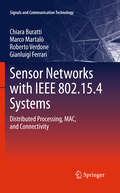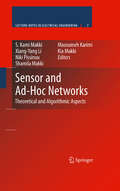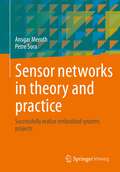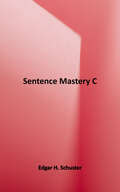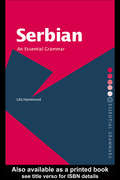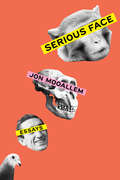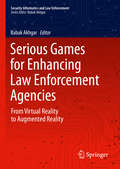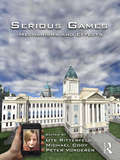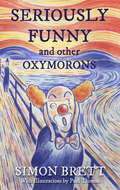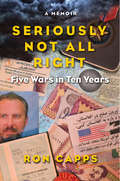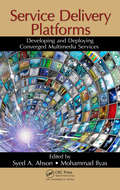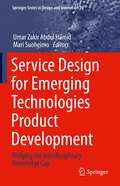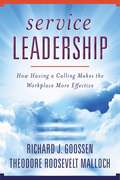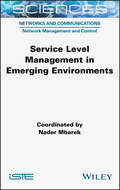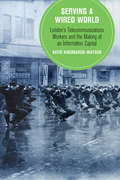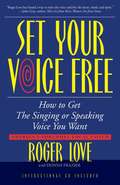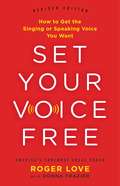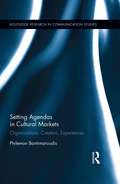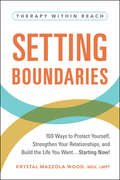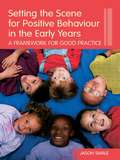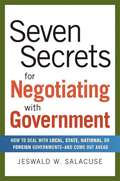- Table View
- List View
Sensor Networks with IEEE 802.15.4 Systems
by Roberto Verdone Gianluigi Ferrari Marco Martalo' Chiara BurattiThis book presents a simple, yet complete, approach to the design and performance analysis of distributed processing algorithms and techniques suitable for IEEE 802.15.4 networks. In particular, the book focuses on the bottom two layers of the ISO/OSI stack (Physical and Medium Access Control), discussing also a few issue related to routing. The book is a the synergistic combination of signal processing aspects on the one hand and MAC and connectivity issues on the other hand. The goal of the book is to clearly link physical layer aspects with medium access and topology aspects, in order to provide the reader with a clear understanding of how to approach the design of proper distributed signal processing and medium access algorithms in this context.
Sensor and Ad-Hoc Networks
by Xiang-Yang Li Kia Makki S. Kami Makki Niki Pissinou Masoumeh Karimi Shamila MakkiThis book brings together leading researchers and developers in the field of wireless sensor networks to explain the special problems and challenges of the algorithmic aspects of sensor and ad-hoc networks. The book also fosters communication not only between the different sensor and ad-hoc communities, but also between those communities and the distributed systems and information systems communities. The topics addressed pertain to the sensors and mobile environment.
Sensor networks in theory and practice: Successfully realize embedded systems projects
by Ansgar Meroth Petre SoraThe book provides an important foundation for understanding the Internet of Things by offering insight into common networking protocols from the microcontroller world and introducing important sensors and other devices, as well as their use and programming. All concepts shown are illustrated with practical circuit and programming examples from the authors' many years of experience. In addition, open libraries for controlling the devices presented in the book are available for readers to download from the publisher's home page. The second edition includes some new devices, especially in the area of networks, a more detailed description of the operating principles of some sensors as well as further tips and tricks for programming.
Sensornetzwerke in Theorie und Praxis: Embedded Systems-Projekte erfolgreich realisieren
by Ansgar Meroth Petre SoraDas Buch bildet eine wichtige Grundlage für das Verständnis des Internet of Things, indem es einen Einblick in gängige Vernetzungsprotokolle aus der Mikrocontrollerwelt bietet und wichtige Sensoren und andere Bausteine, sowie deren Einsatz und Programmierung vorstellt. Alle gezeigten Konzepte werden durch praktische Schaltungs- und Programmierbeispiele aus den langjährigen Erfahrungen der Autoren illustriert. Daneben stehen den Lesern offene Bibliotheken für die Ansteuerung der im Buch präsentierten Bauteile auf der Verlagshomepage zum Herunterladen bereit. Die zweite Auflage beinhaltet einige neue Bausteine, insbesondere im Bereich der Netzwerke, eine ausführlichere Beschreibung der Funktionsprinzipien einiger Sensoren sowie weitere Tipps und Tricks zum Programmieren.
Sensors: Theory, Algorithms, and Applications (Springer Optimization and Its Applications #61)
by Panos M. Pardalos Vladimir L. Boginski Yinyu Ye Clayton W. CommanderThe objective of this book is to advance the current knowledge of sensor research particularly highlighting recent advances, current work, and future needs. The goal is to share current technologies and steer future efforts in directions that will benefit the majority of researchers and practitioners working in this broad field of study.
Sentence Mastery - Book C, Second Edition
by Edgar H. SchusterThis book is for you. Its purpose is to help make you a better writer. It is based on an old idea--that one can improve a skill by practice. You know that batters improve by practicing hitting. Piano players improve by practicing the piano. Carpenters improve by practicing their trade. There is every reason to believe that you will improve as a writer by writing. Yet it is not certain that you will improve only by writing. Student writers who do not know certain fundamentals may merely repeat their errors. This book offers carefully controlled practice. If you can understand a few basic clues, you will not merely write sentences, you will write good sentences. By the time you have finished this book, you will have written hundreds of good sentences. You will be well on your way toward sentence mastery. In addition to writing good sentences, you will also gain practice in writing correct forms of words. For example, you will practice writing write and right, past and passed, to mention only two of the twenty items in this book. In the first problem or two in early lessons, we call attention to these troublesome words by printing them in boldfaced italics. Boldfaced italics look like this: write, right; past, passed. In later lessons you will receive much additional practice writing such troublesome words. Some people naturally work faster than others. If you are one of these fast workers, you will find extra practice for each lesson at the back of the book, beginning on page 129. If you finish any lesson before your classmates, turn to the proper page near the end of the book and you will find more sentences to do. This book may also help you to improve your punctuation, capitalization, spelling, and even your handwriting.
Sentiment Analysis
by Bing LiuSentiment analysis and opinion mining is the field of study that analyzes people's opinions, sentiments, evaluations, attitudes, and emotions from written language. It is one of the most active research areas in natural language processing and is also widely studied in data mining, Web mining, and text mining. In fact, this research has spread outside of computer science to the management sciences and social sciences due to its importance to business and society as a whole. The growing importance of sentiment analysis coincides with the growth of social media such as reviews, forum discussions, blogs, micro-blogs, Twitter, and social networks. For the first time in human history, we now have a huge volume of opinionated data recorded in digital form for analysis. Sentiment analysis systems are being applied in almost every business and social domain because opinions are central to almost all human activities and are key influencers of our behaviors. Our beliefs and perceptions of reality, and the choices we make, are largely conditioned on how others see and evaluate the world. For this reason, when we need to make a decision we often seek out the opinions of others. This is true not only for individuals but also for organizations. This book is a comprehensive introductory and survey text. It covers all important topics and the latest developments in the field with over 400 references. It is suitable for students, researchers and practitioners who are interested in social media analysis in general and sentiment analysis in particular. Lecturers can readily use it in class for courses on natural language processing, social media analysis, text mining, and data mining. Lecture slides are also available online. Table of Contents: Preface / Sentiment Analysis: A Fascinating Problem / The Problem of Sentiment Analysis / Document Sentiment Classification / Sentence Subjectivity and Sentiment Classification / Aspect-Based Sentiment Analysis / Sentiment Lexicon Generation / Opinion Summarization / Analysis of Comparative Opinions / Opinion Search and Retrieval / Opinion Spam Detection / Quality of Reviews / Concluding Remarks / Bibliography / Author Biography
Serbian: An Essential Grammar (Routledge Essential Grammars)
by Lila HammondSerbian: An Essential Grammar is an up-to-date and practical reference guide to the most important aspects of Serbian as used by contemporary native speakers of the language. Refreshingly jargon free, it presents an accessible description of the language, focusing on the real patterns of use today. A reference source for the learner and user of Serbian irrespective of level, it sets out the complexities of the language in short, readable sections. Features of this Grammar include: * use of Cyrillic and Latin script examples throughout* a cultural section on the language and its dialects* clear and detailed explanations of simple and complex grammatical concepts* detailed contents list and index for easy reference. Well-presented and easy to use, Serbian: An Essential Grammar is ideal either for independent study or for students in schools, colleges, universities and adult education.
Serious Face: Essays
by Jon MooallemFrom the discovery of the author&’s face in a century-old photograph to a triple-amputee hospice director working at the border of life and death, here are thirteen hopeful, heartbreaking, and profound essays from &“one of the most intelligent, compassionate, and curious authors working today&” (Elizabeth Gilbert). ONE OF THE MOST ANTICIPATED BOOKS OF 2022—Lit HubBeneath the self-assured and serious faces we wear, every human life is full of longing, guesswork, and confusion—a scramble to do the best we can and make everything up as we go along. In these wide-ranging essays, Jon Mooallem chronicles the beauty of our blundering and the inescapability of our imperfections. He investigates the collapse of a multimillion-dollar bird-breeding scam run by an aging farmer known as the Pigeon King, intimately narrates a harrowing escape from California&’s deadliest wildfire, visits an eccentric Frenchman building a town at what he claims is the center of the world, shadows a man through his first day of freedom after twenty-one years in prison, and more—all with a deep conviction that it&’s our vulnerability, not our victories, that connect us.Mooallem&’s powers of perception have established him as one of the most distinctive, empathic, and clear-sighted narrative journalists working today. The Wall Street Journal has called his writing &“as much art as it is journalism,&” and Jia Tolentino has praised his &“grace and command.&” In Serious Face, Mooallem brings to life the desperate hopes and urgent fears of the people he meets, telling their stories with empathy, humor, insight, and kindness. These elegant, moving essays form an idiosyncratic tapestry of human experience: our audacity and fallibility, our bumbling and goodwill. In moments of calamity and within the extreme absurdity of everyday life, can we learn to love the people we really are, behind the serious faces we show the world?
Serious Games for Enhancing Law Enforcement Agencies: From Virtual Reality to Augmented Reality (Security Informatics and Law Enforcement)
by Babak AkhgarThis book provides a comprehensive and practically minded introduction into serious games for law enforcement agencies. Serious games offer wide ranging benefits for law enforcement with applications from professional trainings to command-level decision making to the preparation for crises events. This book explains the conceptual foundations of virtual and augmented reality, gamification and simulation. It further offers practical guidance on the process of serious games development from user requirements elicitation to evaluation. The chapters are intended to provide principles, as well as hands-on knowledge to plan, design, test and apply serious games successfully in a law enforcement environment. A diverse set of case studies showcases the enormous variety that is possible in serious game designs and application areas and offers insights into concrete design decisions, design processes, benefits and challenges. The book is meant for law enforcement professionals interested in commissioning their own serious games as well as game designers interested in collaborative pedagogy and serious games for the law enforcement and security sector.
Serious Games: Mechanisms and Effects
by Michael Peter Vorderer Ritterfeld Ute CodySerious Games provides a thorough exploration of the claim that playing games can provide learning that is deep, sustained and transferable to the real world. "Serious games" is defined herein as any form of interactive computer-based game software for one or multiple players to be used on any platform and that has been developed to provide more than entertainment to players. With this volume, the editors address the gap in exisiting scholarship on gaming, providing an academic overview on the mechanisms and effects of serious games. Contributors investigate the psychological mechanisms that take place not only during gaming, but also in game selection, persistent play, and gaming impact. The work in this collection focuses on the desirable outcomes of digital game play. The editors distinguish between three possible effects -- learning, development, and change -- covering a broad range of serious games’ potential impact. Contributions from internationally recognized scholars focus on five objectives: Define the area of serious games Elaborate on the underlying theories that explain suggested psychological mechanisms elicited through serious game play, addressing cognitive, affective and social processes Summarize the empirical evidence on the effectiveness of serious games, Introduce innovative research methods as a response to methodological challenges imposed through interactive media Discuss the possibilities and limitations of selected applications for educational purposes. Anchored primarily in social science research, the reader will be introduced to approaches that focus on the gaming process and the users’ experiences. Additional perspectives will be provided in the concluding chapters, written from non-social science approaches by experts in academic game design and representatives of the gaming industry. The editors acknowledge the necessity for a broader interdisciplinary study of the phenomena and work to overcome the methodological divide in games research to look ahead to a more integrated and interdisciplinary study of digital games. This timely and singular volume will appeal to scholars, researchers, and graduate students working in media entertainment and game studies in the areas of education, media, communication, and psychology.
Seriously Funny, and Other Oxymorons
by Simon Brett'Brilliant! Will make a perfect Xmas stocking filler' Bronya Ralley'Delightful. This dip-in-anywhere book put a smile on my face from the first page . . . for everyone who likes a good chuckle' Ruth MilliganAs we all know, the oxymoron is one of the great beauties of the English language. It has been defined as 'a figure of speech that juxtaposes elements that appear to be contradictory'. Famous examples would include 'bitter-sweet', 'open secret' and 'compassionate Conservatism'.Seriously Funny, and Other Oxymorons brings together a great many examples of the oxymoron genre, amusingly illustrated by Paul Thomas. The book is arranged according to various categories ranging from Popular Culture to Political Principles and Business Ethics, all covered in Simon Brett's inimitably witty style.Anyone with an 'unbiased opinion' will quickly grasp that Seriously Funny makes a 'devilishly nice' book.
Seriously Funny, and Other Oxymorons (Gift Books)
by Simon Brett'Brilliant! Will make a perfect Xmas stocking filler' Bronya Ralley'Delightful. This dip-in-anywhere book put a smile on my face from the first page . . . for everyone who likes a good chuckle' Ruth MilliganAs we all know, the oxymoron is one of the great beauties of the English language. It has been defined as 'a figure of speech that juxtaposes elements that appear to be contradictory'. Famous examples would include 'bitter-sweet', 'open secret' and 'compassionate Conservatism'.Seriously Funny, and Other Oxymorons brings together a great many examples of the oxymoron genre, amusingly illustrated by Paul Thomas. The book is arranged according to various categories ranging from Popular Culture to Political Principles and Business Ethics, all covered in Simon Brett's inimitably witty style.Anyone with an 'unbiased opinion' will quickly grasp that Seriously Funny makes a 'devilishly nice' book.
Seriously Not All Right: Five Wars in Ten Years
by Ron CappsFor more than a decade, Ron Capps, serving as both a senior military intelligence officer and as a Foreign Service officer for the U.S. Department of State, was witness to war crimes, ethnic cleansing, and genocide. From government atrocities in Kosovo, to the brutal cruelties perpetrated in several conflicts in central Africa, the wars in both Aghanistan and Iraq, and culminating in genocide in Darfur, Ron acted as an intelligence collector and reporter but was diplomatically restrained from taking preventative action in these conflicts. The cumulative effect of these experiences, combined with the helplessness of his role as an observer, propelled him into a deep depression and a long bout with PTSD, which nearly caused him to take his own life. Seriously Not All Right is a memoir that provides a unique perspective of a professional military officer and diplomat who suffered (and continues to suffer) from PTSD. His story, and that of his recovery and his newfound role as founder and teacher of the Veterans Writing Project, is an inspiration and a sobering reminder of the cost of all wars, particularly those that appeared in the media and to the general public as merely sidelines in the unfolding drama of world events.
Service Delivery Platforms: Developing and Deploying Converged Multimedia Services
by Mohammad Ilyas Syed A. AhsonIt is becoming increasingly important for telecom operators to be able to provide service delivery platforms (SDP) quickly and efficiently in order to improve the time-to-revenue of value-added services. Presenting a rapid architecture solution to meet this challenge, Service Delivery Platforms: Developing and Deploying Converged Multimedia Service
Service Design for Emerging Technologies Product Development: Bridging the Interdisciplinary Knowledge Gap (Springer Series in Design and Innovation #29)
by Umar Zakir Abdul Hamid Mari SuoheimoThe productization of emerging technologies related to the Fourth Industrial Revolution (FIR) is now getting more attention across different industries. Compared to the previous industrial transformations that the world has seen which relied on mechanical innovations, the ongoing FIR is seeing software and data-driven products as the foundation. Apart from that, topics such as circular and sustainable economy as well as climate change are also disrupting the industrial ecosystem. For a viable and successful productization of emerging technologies, collaborations between interdisciplinary stakeholders are a necessity. One of the elements that has been identified to facilitate this collaboration is service design. This book aimed to provide comprehensive service design discussions for practitioners in different fields and sectors. The aim is to bridge the knowledge gap between experts in academia, business and product development, among many others, to provide a unified understanding of the importance of service design for the productization of emerging technologies. The book consists of an overview of emerging technologies product development and service design, as well as perspectives from different sectors of the industry. The book is expected to benefit multi-disciplinary researchers, practitioners and general audiences with interests in Service Design for Emerging Technologies.
Service Leadership: How Having a Calling Makes the Workplace More Effective
by Theodore Malloch Richard J. GoossenWhat will motivate an organization’s employees to be fully engaged in the corporate purpose? How can a company be more supportive of each individual’s pursuit of workplace meaning? Service Leadership answers these questions and more. “Service leadership” is the recognition and cultivation of the varied interests and beliefs of employees on their quest for purpose at work. An organization will not get the most out of its staff unless it respects each individual’s framework for the pursuit of meaning, which is often done in the context of spirituality and religion. Service leadership takes many forms and is not the same for everyone. People can and want to learn how to become service leaders. Service Leadership shows how these ideas can be implemented through a detailed framework. Extensive research confirms that organizations that do not address the existing core belief systems of employees will be disadvantaged in the marketplace. Interviews with top executives at organizations like Whole Foods, Facebook, Gloria Jean’s Coffee, and Costco shed light on how both companies and employees can utilize service leadership to find and keep meaning in the workplace, improving both job happiness and performance.
Service Level Management in Emerging Environments
by Nader MbarekNetworks are now embedded in daily life thanks to smaller, faster, inexpensive components that are more powerful and increasingly connected. Parallel to this quantitative explosion of communication networks, technology has become more complex. This development comes with challenges related to management and control, and it has become necessary to manage the service level demands of the client to which the service provider commits. Different approaches to managing one or more service level components in different emerging environments are explored, such as: the Internet of Things, the Cloud, smart grids, e-health, mesh networking, D2D (Device to Device), smart cities and even green networking. This book therefore allows for a better understanding of the important challenges and issues relating to Quality of Service (QoS) management, security and mobility in these types of environment.
Serving a Wired World: London's Telecommunications Workers and the Making of an Information Capital (Berkeley Series in British Studies #17)
by Katie Hindmarch-WatsonIn the public imagination, Silicon Valley embodies the newest of the new—the cutting edge, the forefront of our social networks and our globally interconnected lives. But the pressures exerted on many of today’s communications tech workers mirror those of a much earlier generation of laborers in a very different space: the London workforce that helped launch and shape the massive telecommunications systems operating at the turn of the twentieth century. As the Victorian age ended, affluent Britons came to rely on information exchanged along telegraph and telephone wires for seamless communication: an efficient and impersonal mode of sharing thoughts, demands, and desires. This embrace of seemingly unmediated communication obscured the labor involved in the smooth operation of the network, much as our reliance on social media and app interfaces does today.Serving a Wired World is a history of information service work embedded in the daily maintenance of liberal Britain and the status quo in the early years of the twentieth century. As Katie Hindmarch-Watson shows, the administrators and engineers who crafted these telecommunications systems created networks according to conventional gender perceptions and social hierarchies, modeling the operation of the networks on the dynamic between master and servant. Despite attempts to render telegraphists and telephone operators invisible, these workers were quite aware of their crucial role in modern life, and they posed creative challenges to their marginalized status—from organizing labor strikes to participating in deviant sexual exchanges. In unexpected ways, these workers turned a flatly neutral telecommunications network into a revolutionary one, challenging the status quo in ways familiar today.
Set Your Voice Free
by Roger Love Donna FrazierInternationally acclaimed for his work as a vocal coach to a wide range of top recording artists and celebrities -- among them Eminem, Wilson Phillips, Smashing Pumpkins, Al Jarreau, the Beach Boys, Phish, Billy Idol, Tyra Banks, Billy Baldwin, Alicia Silverstone, and many others -- Roger Love has pioneered a technique that effectively connects speakers and singers to parts of their voice they've never used before. Whether your goal is to carry a tune, expand your vocal range, or speak with ease and confidence before an audience, Roger Love provides you with exactly the help you need. Through the innovative techniques and enjoyable exercises in this book and accompanying CD, Love demonstrates how you can strengthen your "middle voice" and navigate smoothly through several octaves without pressure or strain. Set Your Voice Free holds the key to vocal success and satisfaction -- it's like professional voice lessons in book form.
Set Your Voice Free: How to Get the Singing or Speaking Voice You Want
by Roger Love Donna FrazierThe greatest vocal coach in the world will help you get the voice you want. Every time we open our mouths, we have an effect on ourselves and the way others perceive us. The ability to speak clearly and confidently can make or break a presentation, an important meeting, or even a first date. Now, with the advent of Skype, YouTube, podcasting, Vine, and any number of reality talent competitions, your vocal presence has never been more necessary for success or more central to achieving your dreams.Roger Love has over 30 years of experience as one of the world's leading authorities on voice. Making use of the innovative techniques that have worked wonders with his professional clients, Love distills the best of his teaching in SET YOUR VOICE FREE, and shares exercises that will help readers bring emotion, range, and power to the way they speak.This updated edition incorporates what he's learned in the last 15 years as the Internet and talent competitions have completely changed the role your voice plays in your life. These are the new essentials for sounding authentic, persuasive, distinctive, and real in a world that demands nothing less.
Setting Agendas in Cultural Markets: Organizations, Creators, Experiences (Routledge Research in Communication Studies)
by Philemon BantimaroudisThis book draws on agenda setting theory to examine how cultural organizations relate to media in order to increase their visibility, valence, and eventually build their public image. Most organizations have a keen interest in their symbolic presence, as their media visibility influences public knowledge, perceptions and even behaviors. Diminished public funding, in combination with the global proliferation of cultural entities, creates a competitive environment, leading to a transformation of cultural industries. In the book, several questions are under scrutiny: How do cultural organizations acquire symbolic significance? How do they become prominent in media content? Which mechanisms and processes should be examined by cultural managers as they set out to achieve salience? Is there a relationship between media and public salience? In other words, if an organization becomes symbolically prominent, in what ways is the public influenced, both in terms of perceptions as well as behaviors?
Setting Boundaries: 100 Ways to Protect Yourself, Strengthen Your Relationships, and Build the Life You Want…Starting Now! (Therapy Within Reach)
by Krystal Mazzola WoodBuild healthy boundaries, manage difficult relationships, and live a happy life in accordance with your personal values with this unique, activity-based supplement to start or support your therapy practice.Setting boundaries can be tough—you don&’t want to disappoint other people, but you also don&’t want to be stuck in a situation that makes you uncomfortable or unhappy. The good news is that setting healthy boundaries is really a good thing that can make you happier and strengthen those relationships you were so worried about. So how do you get started? Setting boundaries is an important skill, and the only way to get better is by practicing. In this book, you&’ll find 100 activities that will help you become better at setting boundaries. Dive into activities that will get you thinking about and practicing those boundaries that are most important to you. You&’ll learn: -How to find your boundary-setting role model to encourage you in those tough moments -How to consider your authentic schedule…and then how to give up on tasks and activities that don&’t match your values to set boundaries around your personal time -How to develop authentic holiday celebrations while navigating complicated family situations -How to say no gently -And much more! Whether you&’re a recovering people pleaser or want to build new boundaries that match other changes in your life, these activities will give you the tools you need to get started. Boundaries are healthy, important, and even necessary to create the life you want—so start building your happier life today!
Setting the Scene for Positive Behaviour in the Early Years: A Framework for Good Practice
by Jason SwaleThis highly practical book shows how staff in early years settings can implement simple changes to make positive behaviour a reality for all. Based on his vast experience in the field, the author provides an array of positive behaviour strategies that can be successful with the widest variety of children, whatever the reason for their behaviour. Designed to appeal to and be accessible for all early years practitioners, this book includes strategies and advice on: how to structure learning environments to encourage positive behaviour providing equality of opportunity, and responding to individual needs teaching emotional literacy working in partnership with parents positive strategies for working with children with autism, ADHD, or withdrawn or distressed children. Supported by extensive case studies, photocopiable material and pro formas, this book will be essential reading for early years workers in a wide variety of settings, as well as students studying childcare at NVQ or degree level.
Seven Secrets for Negotiating with Government: How to Deal with Local, State, National, or Foreign Governments--and Come Out Ahead
by Jeswald SalacuseAlmost everyone has faced the frustrating task of negotiating with government-local, state, national, or foreign-at some point in their lives. Whether they are applying for a building permit from their local zoning board, trying to sell software to the U.S. Defense Department, looking for approval for a merger, or planning to set up a business in Limerick or Bangalore, businesspeople confront a unique set of challenges when dealing with any form of government. Distinguished author, professor and negotiation expert Jeswald W. Salacuse explains the ways in which negotiating with government is very different from private negotiation. In Seven Secrets for Negotiating with Government, he addresses the key variables involved-from the influence of bureaucracy to the perception of power on the government side of the negotiating table. The only book of its kind, this invaluable guide offers succinct, realistic, and accessible advice to help readers recognize the often-hidden interests driving government negotiators and how to use that knowledge to their advantage. Filled with real-life examples, this book will show businesspeople everywhere how to navigate this complex world and win.
